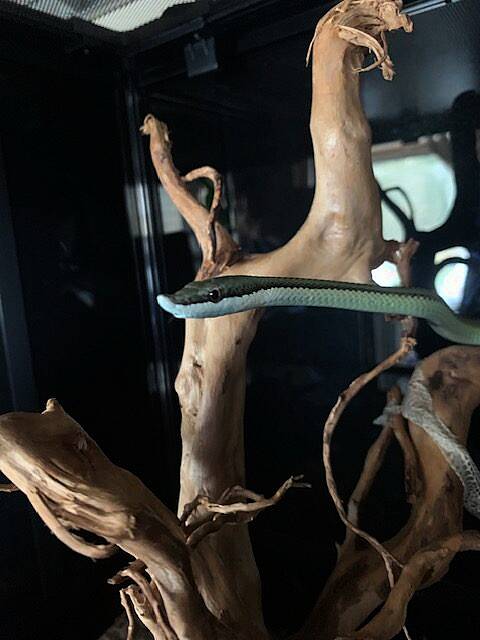YOU may have seen hero-versus-snake movies, but did you know that St Patrick once studied near Cannes, home of the famous film festival, at Lérins?
BY KATHRYN M CROWLEY
The island had no fresh water, and plenty of snakes. When Honoratus prayed, a spring of fresh liquid gushed from the rock.
Then he drove all the snakes into the sea.
Later, Anglo-Norman writers embellished Saint Patrick’s bio with parts of Honoratus’s story.
In 1744 Oliver Goldsmith noted that religion and prejudice had taught people to detest snakes.
Today, some cultures see snakes as both good and evil, however negative beliefs persist in English-speaking cultures.
2025 is Chinese Year of the Green Snake.
On his journey to becoming a herpetologist, John Dunbar studied green anacondas in South American swamps. He also researches snake venom for medical use.
In January, a kingsnake was micro-chipped in Ireland for the first time. John is keen to highlight that the vast majority of snakes kept as pets worldwide are completely harmless.
‘There are of course some species that only advanced keepers with experience should keep, but we should be careful not to label all snakes as dangerous,’ he said.
‘We don’t ban housecats because someone in America was mauled by their pet Bengal tiger.
Once they are provided with a suitable size enclosure, snakes are relatively easy to maintain and make suitable pets. Over the years I have travelled worldwide to see and catch snakes in deserts, swamps, and jungles, there are certainly worse hobbies out there!’
John’s nine-year old son keeps a little corn snake in a vivarium in his bedroom.
That species was Charlie Dale’s first pet snake when his mother set up the Bantry Pet and Equine store.
Today, Charlie is a professional animal carer at Fota Wildlife Park.
‘Corn snakes are extremely easy to mind for beginners. Bull pythons are also on easy-care level,’ he explained.
‘My mum wouldn’t sell any snake to a beginner unless it was simple to look after.’
 One of Charlie's rarer snakes, a Baron's Green Racer.
One of Charlie's rarer snakes, a Baron's Green Racer.
What are the common concerns?
‘People think that they’re super difficult to look after and they worry if it’s viable, but a corn snake takes less attention than a rabbit or guinea pig,’ Charlie said.
‘Starting can be expensive, or cheap as chips: you could spend three hundred euros on a glass tank, but there’s actually no need. More expensive models have a temperature control.
However, an acrylic tank, heat mat, and bedding can be very basic, so the cost is minimal.’ His first set-up cost around €50.
‘People don’t realise that snakes prefer to stay hidden: they don’t think or move in the same way as mammals. I always give a snake a minimum length of the length of their body,’ he said, adding that big spaces can cause serpentine stress.
Once he halved a tank with a divider, as is pet was anxious and not eating well. ‘Snakes don’t eat daily, and they have a slow metabolism,’ he added. ‘They eat frozen rodents which can be off-putting to people. They enjoy cosy confined spaces so that they can move around without being seen.
‘Snakes love clutter; plants (fake or real) and stuff to live hide under, or in, are ideal. They simply need constant access to water and a heat mat under the tank.’
What other mistaken beliefs abound?
‘I work a lot in Fota tropical house, and a common one is people thinking that snakes are slimy to the touch. Actually, they’re dry: their skin feels like leather.
‘Often people think that all snakes are venomous, and they can all kill you: in Fota, the snakes are non-venomous.
‘People are not aware that snakes don’t have ears: they hear through vibration. When children visit, they get super-excited, naturally, and they jump up and down. Some people might bang on the sides of the tank, not realising that it causes a vibration in the head of the animal, which can upset the snake,’ he concluded.
We shed our skin regularly, and the process goes unnoticed. For snakes, skin doesn’t grow as the animal expands, so the old skin eventually peels away, taking with it any parasites that latched on to the animal. We too can shed what doesn’t serve us. Snakes are not treacherous, misinformation is.









